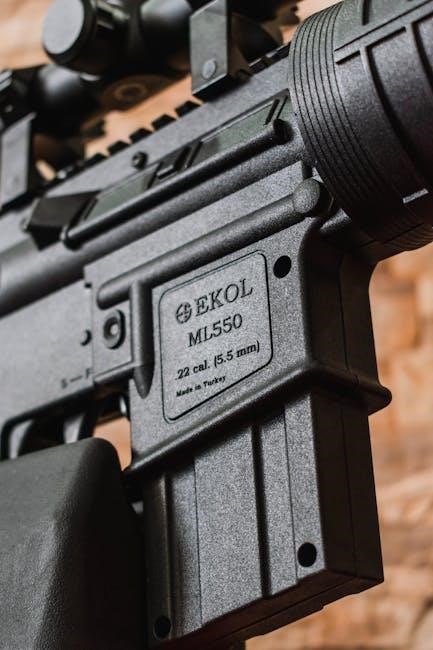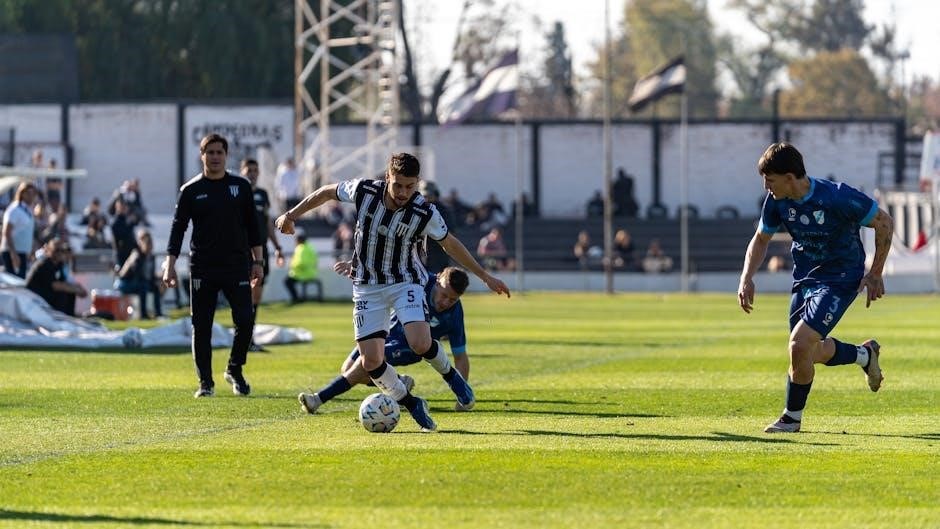The 3-5-3 defense playbook offers a versatile and aggressive scheme, excelling in stopping the run and covering passes. Its flexibility allows for multiple formations and adjustments, making it ideal for youth and high school teams. By combining strong run fits with effective coverage options, this playbook provides a solid foundation for defensive success.
1.1 Overview of the 3-5-3 Defense

The 3-5-3 defense is a versatile and aggressive scheme that utilizes three defensive linemen, five linebackers, and three defensive backs. It is highly effective in stopping the run and covering passes, making it a popular choice for youth and high school teams. The defense emphasizes flexibility, allowing for multiple adjustments and blitz packages. Its unique alignment often confuses offenses, as it can resemble both a 4-3 and 5-3 front. This playbook focuses on sound fundamentals, gap responsibilities, and coverage techniques, providing a balanced approach to defensive strategy.
1.2 Key Concepts and Philosophy
The 3-5-3 defense revolves around key concepts such as gap responsibility, run fits, and coverage discipline. Its philosophy emphasizes simplicity and execution, allowing players to react quickly without overcomplicating assignments. The defense prioritizes stopping the run first, using a stacked box to create a physical presence. Coverage schemes are designed to confuse quarterbacks while ensuring underneath support. Flexibility is a cornerstone, enabling adjustments to counter various offensive formations. This approach fosters a cohesive unit, where each player understands their role within the larger defensive strategy, leading to consistent performance and adaptability in game situations.
Base Formation and Alignment
The 3-5-3 defense features three defensive linemen, five linebackers, and three defensive backs. This formation emphasizes gap control, run stopping, and versatile pass coverage responsibilities for all players.
2.1 Positions and Responsibilities
In the 3-5-3 defense, the three defensive linemen are responsible for occupying blockers and controlling gaps. The five linebackers serve as the backbone, with responsibilities including stopping the run, covering underneath zones, and blitzing. The three defensive backs focus on deep coverage and supporting the run. Each position requires clear communication and disciplined execution to ensure proper run fits and pass coverage. The scheme relies on players understanding their assignments and reacting quickly to offensive plays, making it essential for coaches to emphasize alignment and responsibility in practice drills.
2.2 Defensive Line Techniques
The defensive line in the 3-5-3 playbook employs techniques like the “pinch and loop” to occupy blockers and control gaps. Defensive ends are often tasked with setting the edge and containing the run, while defensive tackles focus on occupying the center and guards. These techniques ensure linebackers have clear paths to fill gaps. The line must maintain discipline to prevent overcommitting, allowing the linebackers to flow freely. Proper hand placement and footwork are emphasized to maximize effectiveness. These techniques are foundational for stopping the run and creating pressure in the 3-5-3 scheme.
2.3 Linebacker and Secondary Alignment
In the 3-5-3 defense, linebackers typically align in a stacked formation behind the defensive line, allowing them to flow freely to the ball. The middle linebacker often serves as the defensive quarterback, calling signals and directing the unit. Outside linebackers are positioned to cover the flats and support the edge against the run. The secondary, featuring three defensive backs, aligns in a way that provides deep support while also being aggressive in run support. Safeties often play a pivotal role, rotating to fill gaps or provide coverage depending on the situation. Proper alignment ensures all gaps are covered and responsibilities are clear.

Coverage Schemes
The 3-5-3 defense employs versatile coverage schemes, including Cover 3, Cover 1, and man-to-man techniques, to disrupt offenses while maintaining strong run support and gap integrity.
3.1 Cover 3 Zone Coverage
Cover 3 Zone Coverage is a cornerstone of the 3-5-3 defense, providing deep security with three defenders splitting the field into thirds. Corners and safeties each patrol a zone, ensuring balanced coverage. Linebackers and defensive linemen focus on underneath zones, disrupting short routes and run plays. This scheme excels against deep passes and forces offenses into check-downs. It’s particularly effective when combined with pressure packages, as it limits big plays while maintaining run integrity. Proper communication and zone discipline are key to its success, making it a reliable base coverage for various game situations.
3;2 Cover 1 Man-Free Coverage
Cover 1 Man-Free Coverage combines aggressive man-to-man defense with a single deep safety. Corners and linebackers cover receivers man-to-man, while the safety provides deep support. This scheme pressures offenses by eliminating deep threats and forcing quick decisions. Defensive linemen and linebackers often blitz to disrupt the quarterback’s rhythm. The safety’s role is critical, as they must read the quarterback and provide help over the top. This coverage excels in short-yardage situations and against teams relying on deep passes. Proper communication and technique are essential to avoid gaps in coverage and ensure defensive success in high-pressure moments.
3.3 Man-to-Man Coverage Techniques
Man-to-man coverage in the 3-5-3 defense relies on aggressive, press-style techniques to disrupt receivers. Corners and linebackers are responsible for mirroring their assignments, maintaining inside or outside leverage. Press coverage at the line of scrimmage disrupts timing routes, while off-man techniques allow defenders to read the quarterback’s eyes. Safeties often provide deep support, but their primary focus is on robber routes. Linebackers must stay disciplined, avoiding overcommitting to play-action fakes. This coverage excels in third-and-long situations, forcing quarterbacks to make quick, accurate throws. Proper footwork and hand placement are critical for success in man-to-man schemes.
Run Defense Strategies
The 3-5-3 defense excels in run defense through disciplined alignment, gap control, and coordination between the defensive line and linebackers, ensuring all rush lanes are covered effectively.
4.1 Gap Responsibilities and Run Fits
In the 3-5-3 defense, each player has clear gap responsibilities to ensure effective run defense. The defensive line focuses on occupying blockers and controlling specific gaps, while linebackers fill their assigned gaps aggressively. The secondary provides support by fitting into the run quickly. Proper alignment and communication are key to avoiding gaps. By pinching the defensive line and spacing linebackers, the defense covers all potential run lanes. This coordination ensures consistent stoppage of the run, making the 3-5-3 a reliable scheme for defending rushing attacks at both youth and high school levels.
4.2 Stopping the Run with the 3-5-3
The 3-5-3 defense excels at stopping the run by leveraging its stacked linebacker formation and aggressive gap responsibilities. The base 3-5-3 alignment provides a strong presence in the box, with defensive linemen occupying blockers and linebackers filling gaps quickly. Pinching the defensive line and spacing linebackers ensures all run lanes are covered. Additionally, blitz packages like nickel and dime alignments can be used to add pressure. The defense’s flexibility allows it to adapt to various offensive formations, ensuring consistent run defense. Proper execution and coordination among players are key to its effectiveness against both power and speed runs.
4.3 Defensive Line and Linebacker Coordination
Effective coordination between the defensive line and linebackers is crucial in the 3-5-3 defense. The defensive line must occupy blockers, creating gaps for linebackers to fill. Techniques like pinching and looping ensure proper run fits. Linebackers align based on offensive formations, focusing on gap responsibilities. Communication is key, as linebackers signal adjustments to the defensive line. This coordination ensures all run lanes are covered, allowing the defense to stop the run consistently. Proper execution of these assignments enables the 3-5-3 to dominate against both power and speed-based running attacks.
Pass Rush and Blitz Packages
The 3-5-3 defense employs aggressive pass rush techniques, utilizing defensive line stunts and linebacker blitzes. Secondary blitz packages add pressure, creating chaos for opposing offenses effectively.
5.1 Defensive End and Outside Linebacker Rush
The defensive ends and outside linebackers are key to generating pressure in the 3-5-3 defense. They utilize speed rushes and stunts to disrupt the quarterback’s rhythm. Defensive ends often pinch inside to create interior pressure, while outside linebackers attack the edges. Their ability to bend and flatten keeps offensive tackles guessing. Additionally, they must maintain contain responsibilities to prevent quarterback escapes. This rush package is complemented by blitzing linebackers and secondary players, creating a chaotic pass rush that forces quick decisions and turnovers. Proper coordination ensures consistent pressure while maintaining coverage integrity behind the rush. This combination is devastating when executed correctly.
5.2 Interior Defensive Line Pass Rush Techniques

The interior defensive line in the 3-5-3 defense employs slants, angles, and penetration techniques to disrupt the pocket. Defensive tackles use quick get-offs and hand-fighting to occupy blockers, creating gaps for edge rushers. They often execute loops and stunts to confuse offensive linemen and exploit weaknesses. Their primary goal is to collapse the pocket inward, forcing the quarterback into the arms of outside rushers. Additionally, interior linemen must maintain gap integrity to prevent quarterbacks from escaping up the middle. This coordination between interior and edge rushers creates a balanced and relentless pass rush, making it difficult for offenses to protect consistently. Proper technique execution is crucial for success in this scheme.
5.3 Blitzing from the Secondary
Blitzing from the secondary in the 3-5-3 defense adds unpredictability and pressure on the quarterback. Safeties and corners execute delayed or immediate blitzes, exploiting offensive line weaknesses. Techniques include man-free coverages, where one safety blitzes while the other provides deep support. Nickel packages often feature linebacker blitzes, with defensive backs rolling into coverage. Timing and coordination are critical to avoid gaps in coverage. These blitzes complement interior and edge rushers, creating a balanced pass rush. Proper communication ensures defenders fill gaps and maintain coverage integrity, making the secondary a dynamic part of the defensive attack. This strategy enhances overall defensive effectiveness.

Adjustments and Variations
The 3-5-3 defense adapts to offensive formations with nickel and dime packages, pre-snap shifts, and situational strategies, ensuring flexibility and effectiveness against various offensive schemes and strengths.
6.1 Nickel and Dime Packages
The 3-5-3 defense incorporates nickel and dime packages to enhance flexibility. Nickel replaces a linebacker with a fifth defensive back, improving pass coverage, while dime adds a sixth for added depth. These packages allow the defense to adapt to pass-heavy offenses, with blitzing corners and safeties creating pressure. By substituting personnel, the 3-5-3 maintains its aggressive nature while covering multiple gaps. These adjustments ensure the defense remains balanced, capable of disrupting both the run and pass game effectively. Proper communication and coordination are key to executing these variations seamlessly.

6.2 Adjusting to Offensive Formations
The 3-5-3 defense excels at adapting to various offensive formations. Against heavy sets like pro or I-formation, the defense can shift to a stacked look, emphasizing run defense. For spread or trips formations, the secondary adjusts to ensure proper coverage matchups. The flexibility of the 3-5-3 allows for seamless transitions, whether it’s sliding the front or rotating the secondary. By aligning based on offensive strength, the defense maintains balance and limits exploitable gaps. Pre-snap reads and communication are critical to executing these adjustments effectively, ensuring the defense remains one step ahead of the offense.
6.3 Situational Defense Strategies
The 3-5-3 defense shines in situational football, adapting to critical moments like third downs, red-zone defense, and end-of-half scenarios. In third-and-long situations, blitz packages from the secondary or linebackers can pressure the quarterback. In the red zone, the defense can shift to a more compact alignment, focusing on underneath coverage and run stops. End-of-half situations may call for conservative looks to prevent big plays. The 3-5-3’s flexibility allows coaches to tailor strategies to the game’s flow, ensuring the defense is prepared for any situation while maintaining its aggressive identity.

Coaching and Teaching the 3-5-3 Defense
Effective coaching involves clear communication, repetitive drills, and emphasizing player assignments. Teach fundamentals like gap responsibilities and coverage techniques to build a cohesive, adaptable defense.
7.1 Player Assignments and Communication

Clear player assignments and communication are critical in the 3-5-3 defense. Each position has defined roles, from defensive linemen occupying blockers to linebackers filling gaps. Safeties must communicate coverage adjustments, ensuring alignment with corners. Verbal cues and hand signals help coordinate pre-snap adjustments. Players must understand their responsibilities and trust teammates to execute their roles. Effective communication ensures seamless execution, especially in blitz packages and coverage schemes. Coaches should emphasize repetitive drills to build muscle memory and confidence in assignments. Proper alignment and communication are the backbone of a successful 3-5-3 defense, allowing players to react decisively to offensive threats.
7.2 Practice Drills for the 3-5-3
Effective practice drills for the 3-5-3 defense focus on fundamentals and scheme execution. Start with bag drills for defensive linemen to practice gap penetration and hand placement. Linebackers benefit from tackling stations and gap-fit exercises to refine their run-stopping techniques. Secondary players should engage in coverage drills, emphasizing zone drops and man-to-man transitions. Blitz timing drills are essential for coordination between linebackers and defensive backs. Incorporate live scrimmages to simulate game situations, allowing players to apply assignments and communication skills. Film study and corrective feedback are crucial for improvement. These drills ensure players master their roles and execute the 3-5-3 defense effectively.
7.3 Game Planning and In-Game Adjustments
Game planning for the 3-5-3 defense involves analyzing opponents’ strengths and tailoring strategies to exploit weaknesses. Coaches should identify key offensive threats and prepare specific coverages or blitz packages to counter them. During games, adjustments are crucial, such as shifting between Cover 3 and man-to-man based on down-and-distance situations. Communicating adjustments quickly ensures players align correctly. Defensive backs must adapt coverage depths, while linebackers adjust run fits. Coaches should remain flexible, leveraging situational strategies like nickel packages or extra pressure in critical moments. Effective in-game adjustments enhance the defense’s ability to respond to offensive changes and maintain control of the game flow.
The 3-5-3 defense playbook is a versatile and effective scheme, offering strong run defense and pass coverage options. Its adaptability makes it ideal for teams at various levels.
8.1 Summary of the 3-5-3 Defense

The 3-5-3 defense is a versatile and aggressive scheme that excels in stopping the run and covering passes. It utilizes three defensive linemen, five linebackers, and three defensive backs, providing flexibility in alignments and adjustments. Key concepts include gap responsibilities, run fits, and coverage schemes like Cover 3 and man-to-man. The defense is highly adaptable, allowing coaches to adjust to various offensive formations and situations. Its effectiveness lies in balancing strong run defense with solid pass coverage, making it a reliable choice for teams at multiple levels of competition.
8.2 Final Thoughts and Recommendations
The 3-5-3 defense is a powerful scheme that balances run stopping and pass coverage, making it ideal for teams seeking versatility. Coaches should emphasize understanding gap responsibilities, run fits, and coverage assignments to maximize its effectiveness. Players must communicate clearly and adjust seamlessly to offensive shifts. While the playbook offers flexibility, consistency in execution is key. Teams should practice situational strategies and blitz packages to exploit weaknesses. For optimal results, combine the 3-5-3 with sound fundamentals and adaptability. This defense thrives when players are disciplined and coaches are proactive in game planning.

